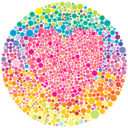Color Blindness Affects Learning
As toddlers grow, some of the first things they learn are colors and shapes. When you think about early children’s games such as Candyland, Go Fish, and Uno – they all depend on recognizing colors. Children that have color blindness will have trouble distinguishing between colors, or not be able to recognize color at all. Color vision deficiency, or color blindness, is a hereditary trait that has a 50% chance to be genetically passed down.
As children enter school the problem continues as most grade schools focus on learning through letters, numbers, and colors. A child that can’t discern between colors is already at a disadvantage as the foundations of learning are built upon in the early years of education. They need help overcoming this obstacle since many schools heavily rely on colors to relay educational messages and lessons.
If a child is suspected of being color blind some clues to look out for are:
- Reading issues with colored pages or worksheets produced with color on color
- Children may complain that their eyes or head hurt if looking at something red on a green background, or vice versa
- Using the wrong colors for an object – e.g. navy leaves on trees, particularly using dark colors inappropriately
- Low attention span when coloring in worksheets
- Problems in identifying red or green color pencils or any color pencil with red or green in its composition. (e.g. purple, brown)
- Identification of color may be made worse by low-level light, small areas of color and colors of the same hue
- Excellent night vision
- Sensitivity to bright lights
The most common types of color blindness are inherited. Color blindness can range greatly in the degree of colors that are able to be seen. Some people can see darker colors easier than light, such as a dark red vs. a light red, with the light red being more difficult to distinguish.
There are three main categories that people who are color blind fall into.
- Red-Green Color Blindness. The most common type of color blindness. It is caused by the loss or limited function of a red cone or green cone photo pigments. People with red-green color blindness struggle to distinguish red and green colors, seeing them as different colors or even black.
- Blue-Yellow Color Blindness. This color loss is rarer than red-green color blindness. The blue-cone photo pigments are either missing or have limited function. This form of color blindness affects the ability to distinguish yellow and often shows yellow and red as pink. Blue can also appear as green and yellows as violet or light gray.
- Complete Color Blindness. People who suffer from complete color blindness see no colors at all. They may also have the clearness of their vision affected in people who suffer from complete color blindness.
There are many tests that your eye doctor can perform to determine if you are color blind. If so, to determine what category of color blindness that you fall into. It is important to have children checked at a young age as many times they do not know that they are color blind.
Children that are born with difficulty seeing colors do not know the difference of what life is like with all colors being portrayed as they should be. Because color blindness is hereditary, it is especially important if one parent is color blind to have regular checkups for the entire family.
There is currently no cure for color blindness, however people with red-green color blindness may be able to use a special set of lenses to help them see colors more accurately. These lenses are typically only to be used outdoors under bright light conditions.
About Bissell Eye Care: John D. Bissell, OD owns and operates Bissell Eye Care servicing Northern Pittsburgh and Alle-Kiski Valley regions. With two locations to treat patients, we offer evening and Saturday appointments. Bissell Eye Care provides comprehensive eye examinations for the entire family beginning as early as 6 months, ocular disease detection and treatment, eyeglasses, sunglasses, activewear, contact lenses, and low vision examinations for those with significant vision loss. We accept most types of vision and health insurance plans. For more information, visit bisselleyecare.com or call our Bakerstown Office at 724-443-6767 or Natrona Heights office at 724-226-0444.

